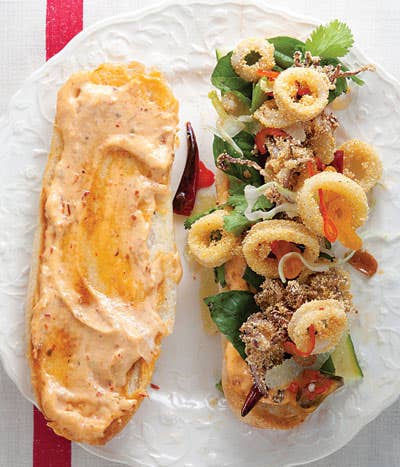
Chef’s Special
Picture yourself as a cook in a restaurant kitchen when the frenetic pace of dinner service begins to taper off. It's after midnight, and you've been on your feet for ten, maybe 12, hours. As the adrenaline dies down, you're bone tired and suddenly overwhelmed by hunger, a marathoner crossing the finish line. This isn't the time or place for a leisurely meal. You grab a couple of pieces of bread from the wait station and start filling them with scraps from your mise-en-place. You eat standing up, eager to get on with cleaning your station, so that you can head to bed or, more likely, to a bar. People always seem curious about what chefs eat. The answer is sandwiches. Lots of sandwiches.
Still, when it comes to those late-night creations, whether at work or at home, we use quality fillings, from homemade aioli to bakery-fresh loaves. We reach for the pork tenderloin from last night's dinner, a half-eaten rotisserie chicken—foods we'd want to consume with or without two slices of bread. Eight years ago, when we created 'wichcraft, our New York City-based chain of sandwich shops, it was with that principle in mind. We choose ingredients that lend the right balance of acid, sweetness, salt, and, sometimes, spice, the same way we design a dish for a restaurant. Sauteed black trumpet mushrooms add an umami note to grilled cheese. Pickled red onions and roasted tomatoes are bright counterpoints to a creamy chicken salad sandwich. Then there's texture: A slaw or salad green introduces bite; avocado, mayonnaise, or a poached egg lends a creamy mouth-feel. One of our favorite sandwiches is a calamari sub that embodies all of these qualities: The richness of the fried seafood is cut by the acid from the lime juice and the heat from the chiles; cilantro and fennel bring fragrance and sweetness; cucumber adds crunch to the soft potato roll and the tender squid.
A sandwich, unlike a restaurant entree, is a meal eaten in the hand, sometimes hours after it's prepared. It needs to be constructed so that it doesn't fall apart. Selecting the right bread is essential—it should be firm enough to absorb moisture without getting soggy, but not so firm that the contents fall out when you clamp your jaw around it. Cheese goes next to the bread to reinforce the structure. Don't put condiments next to lettuce, or they will slide off, right onto your shirt. Greens should go on top, so that they don't get crushed, as should anything wet (tomato, for example), so that the bottom of the sandwich doesn't get damp. Place smaller components, like pickles, between the meat and the cheese, so that they're held firmly in place. It's attention to details like these that makes the difference between a good dish and a great one, whether it comes between two slices of bread or not. —Tom Colicchio and Sisha Ortuzar owners of 'wichcraft and authors of 'wichcraft: Craft a Sandwich Into a Meal—And a Meal Into a Sandwich (Clarkson Potter, 2009)
Keep Reading
Continue to Next Story










